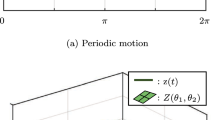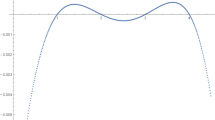Summary
It is known that certain Runge-Kutta methods share the property that, in a constant-step implementation, if a solution trajectory converges to a bounded limit then it must be a fixed point of the underlying differential system. Such methods are calledregular. In the present paper we provide a recursive test to check whether given method is regular. Moreover, by examining solution trajectories of linear equations, we prove that the order of ans-stage regular method may not exceed 2[(s+2)/2] and that the maximal order of regular Runge-Kutta method with an irreducible stability function is 4.
Similar content being viewed by others
References
[AXE1] Axelsson, O.: A class ofA-stable methods. BIT9, 185–199 (1969)
[BEL1] Beyn, W.-J., Lorenz, J.: Center manifolds of dynamical systems under discretization. Numer. Funct. Anal. Optimization9, 381–414 (1987)
[BEY1] Beyn, W.-J.:On invariant closed curves for one-step methods. Numer. Math.51, 103–122 (1987)
[BUR1] Burrage, K.: (to appear)
[BUT1] Butcher, J.C.: Implicit Runge-Kutta processes. Math. Comput.18, 50–64 (1964)
[CHI1] Chipman, F.H.:A-stable Runge-Kutta processes. BIT11, 384–388 (1971)
[DEV1] Dekker, K., Verwer, J.G.: Stability of Runge-Kutta methods for stiff nonlinear equations, 1st Ed. Amsterdam. North-Holland 1984
[EHL1] Ehle, B.L.: On Padé approximations to the exponential function andA-stable methods for the numerical solution of initial value problems. Ph. D. dissertation, Univ. of Waterloo 1969
[GRI1] Griffiths, D.F.: The dynamics of some linear multistep methods with step-size control. In: Griffiths, D.F., Watson, G.A. (eds.) Numerical analysis 1987, pp. 115–134. Harlow: Pitman 1988
[HAL1] Hall, G.: Equilibrium states of Runge-Kutta codes. ACM Trans. Math. Software20, 289–301 (1985)
[HNW1] Hairer, E., Nørsett, S.P., Wanner, G.: Solving ordinary differential equations I: nonstiff problems, 1st Ed. Berlin Heidelberg New York: Springer 1987
[ISE1] Iserles, A.: Stability and dynamics of numerical methods for nonlinear ordinary differential equations. IMA J. Num. Anal.10, 1–30 (1990)
[ISE2] Iserles, A.: Nonlinear stability and asymptotics of O.D.E. solvers. In: Agarwal, R.P. (ed.) International Conference on Numerical Mathematics. Basel. Birkhäuser 1989
[KLL1] Kloeden, P.E., Lorenz, J.: Stable attracting sets in dynamical systems and in their one-step discretizations. SIAM J. Numer. Anal.23, 986–995 (1986)
[PER1] Perron, O.: Die Lehre von den Kettenbrüchen. 3rd ed. Stuttgart: Teubner 1954
[STE1] Stetter, H.J.: Analysis of discretization methods for ordinary differential equations, 1st Ed. Berlin Heidelberg New York: Springer 1973
Author information
Authors and Affiliations
Rights and permissions
About this article
Cite this article
Hairer, E., Iserles, A. & Sanz-Serna, J.M. Equilibria of Runge-Kutta methods. Numer. Math. 58, 243–254 (1990). https://doi.org/10.1007/BF01385623
Received:
Issue Date:
DOI: https://doi.org/10.1007/BF01385623




